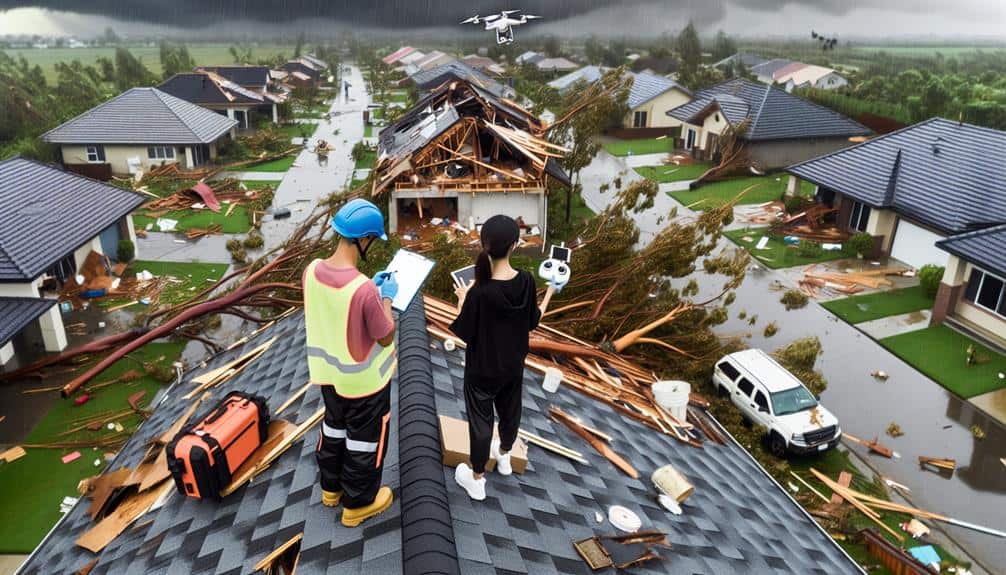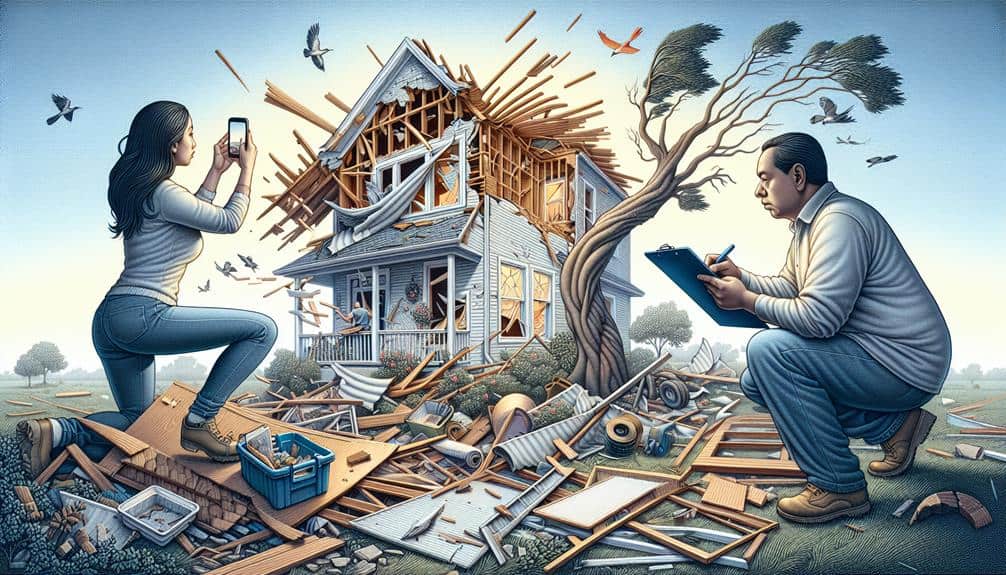When documenting storm damage for inspection, we need a detailed checklist focusing on structural damage, water intrusion, and other storm-related issues. Let's capture timestamped photos using high-quality cameras with metadata. We'll measure and note specific damages with measuring tapes or rulers and make sure safety gear is worn. It's important to document both interior and exterior damage, including foundation cracks, roof collapses, and water stains. Additionally, capturing environmental impacts like flooding and debris, and noting utility disruptions, are necessary. By compiling this evidence and filing insurance claims promptly, we can guarantee a thorough and accurate damage assessment. Learn more by exploring further into each step.
Key Points
- Capture timestamped photos of all structural and environmental damage, ensuring clear documentation for insurance claims.
- Use a high-resolution camera with GPS capabilities to embed accurate location data in photos.
- Include both close-up and wide-angle shots of damage for comprehensive evidence.
- Note specific details of damage, such as dimensions and severity, to support repair estimates.
Preparing for Inspection
Before the inspection begins, we need to gather all necessary documentation and tools to secure a thorough assessment. First, we should create an inspection checklist tailored to the specific types of damage we're likely to encounter. This checklist will guide our damage assessment and ensure we don't overlook any critical areas. It's important to include sections for structural damage, water intrusion, and any other storm-related issues.
Next, let's focus on document organization. We'll need to compile all relevant property records, previous inspection reports, and any photographs or videos that show the property's condition before the storm. These documents will provide a baseline for our assessment and are essential for evidence preservation. Proper organization will make it easier to compare the pre- and post-storm conditions, highlighting any new damage.
We should also prepare a systematic approach for evidence preservation. This involves taking clear, timestamped photos of all damage, making detailed notes, and possibly collecting physical samples if necessary.
Essential Tools and Equipment
As we begin documenting storm damage, we need a reliable camera with spare batteries to capture clear images.
A measuring tape or ruler is essential for accurately recording the dimensions of the damage.
Let's also make sure we have the necessary safety gear to protect ourselves during the inspection.
Camera and Spare Batteries
When documenting storm damage, we must make certain our camera is fully charged and we've spare batteries on hand to avoid interruptions. A reliable camera is vital, as it captures the visual evidence we need for a thorough inspection. Equally significant is having a large-capacity memory card. This guarantees we can take numerous high-resolution photos without worrying about running out of storage space.
Weather protection for our camera is essential, especially when working in inclement conditions. A waterproof camera cover or a weather-resistant camera can prevent damage from rain or debris, making sure our equipment remains functional throughout the inspection. We should also carry a cleaning kit to keep the lens clear from any moisture or particles that might obscure our shots.
Additionally, we recommend carrying multiple memory cards. This not only provides extra storage but also serves as a backup in case of card failure.
Measuring Tape or Ruler
A sturdy measuring tape or ruler is vital for accurately gauging the extent of storm damage. When conducting a damage assessment, taking accurate measurements is crucial. We need to know the exact dimensions of any structural damage, such as the length of cracks, the size of dents, or the height of floodwater marks. This guarantees that our inspection documentation is thorough and dependable.
Using a measuring tape, we can easily record the precise size of damaged areas, which is essential for both insurance purposes and repair estimates. The flexibility of a tape allows us to measure curved or awkwardly positioned damage, something a rigid ruler might've difficulty with.
However, a ruler can be equally valuable, especially for smaller, more precise measurements. When we document storm damage, it's vital to provide precise recording of each measurement. This attention to detail not only supports our claims but also helps contractors in understanding the extent of repairs needed.
Safety Gear Essentials
Ensuring our safety during storm damage inspections starts with wearing necessary safety gear. We need to prioritize our well-being by taking required safety precautions, which include donning protective clothing.
A sturdy helmet is essential to shield our heads from falling debris or low-hanging branches. Safety goggles protect our eyes from dust, splinters, and sharp objects that might be airborne after a storm.
Wearing gloves is crucial to safeguard our hands from cuts, abrasions, and other injuries while handling debris. We should opt for heavy-duty gloves that offer both flexibility and protection. High-visibility vests keep us noticeable to others, especially in low-light conditions or chaotic environments, reducing the risk of accidents.
Footwear shouldn't be overlooked; sturdy, waterproof boots with non-slip soles provide stability on slippery surfaces and protect our feet from sharp objects.
Additionally, a dust mask or respirator helps us avoid inhaling harmful particles, mold, or other contaminants common in storm-damaged areas. A first aid kit should always be on hand for any minor injuries that might occur.
Photographing Damage

When photographing storm damage, we need to think about ideal lighting conditions to guarantee clear images.
We should focus on key damage areas, capturing wide shots and close-ups for a thorough view.
Additionally, utilizing photo metadata helps us organize and timestamp the images accurately.
Optimal Lighting Conditions
To capture clear and detailed images of storm damage, we must prioritize shooting during ideal lighting conditions. Proper lighting is essential for accurately documenting the aftermath of natural disasters. The best time to photograph weather damage is during the early morning or late afternoon when the light is soft and diffused. This avoids harsh shadows and overexposed areas that can obscure essential details.
When we face overcast skies, we get evenly distributed light, which can be advantageous for capturing even subtle damage. Cloud cover acts as a natural diffuser, reducing glare and enhancing the clarity of our visual documentation. However, if we encounter low-light conditions, such as during a storm or at dusk, using a tripod and adjusting the camera's ISO settings can help maintain image quality without introducing noise.
In situations where artificial lighting is necessary, we should use multiple light sources to minimize shadows and guarantee even coverage. Flash units or portable LED lights can be beneficial, but we must balance them to avoid washing out the damage details.
Key Damage Focus Areas
We should always prioritize photographing structural damage, such as roof collapses and broken windows, as these areas typically show the most significant impact from storms. Capturing these images provides essential evidence for insurance claims and repair assessments.
Roof leaks often manifest as water stains on ceilings or visible gaps in roofing materials. We need to photograph these from multiple angles to show the full extent of the damage. Close-ups of the affected areas can highlight specific issues, while wider shots provide context within the structure.
Window damage is another crucial focus area. Broken glass, warped frames, and water intrusion around windowsills should be documented meticulously. We should capture the overall state of the window and any specific breakage or deformation. Photographs should also include the interior and exterior views to illustrate the impact comprehensively.
Using Photo Metadata
Utilizing photo metadata in documenting storm damage allows us to provide precise information about the time, date, and location of each photograph, which is invaluable for accurate reporting and insurance claims. By embedding this information directly in the photos, we create a reliable, verifiable record of the damage.
When we capture images of storm damage, the metadata—such as GPS coordinates, timestamps, and camera settings—gets automatically stored within the image file. This metadata analysis is essential for image verification, ensuring that each photo's details are accurate and tamper-proof. By examining the metadata, we can establish a clear timeline of events and confirm the exact locations affected by the storm.
To maximize the benefits of metadata, we should use cameras or smartphones with GPS capabilities enabled. This way, every picture we take will have embedded location data. Additionally, maintaining the original image files without alterations preserves the integrity of the metadata.
Noting Structural Issues
When evaluating storm damage, it's important to thoroughly document any structural issues such as foundation cracks, roof damage, and compromised support beams.
We'll start by checking for roof leaks, which can cause significant interior damage if not addressed. Look for missing or damaged shingles and any signs of water seepage inside the attic. Document these issues with clear photos and detailed notes.
Next, inspect the foundation for cracks. Even minor cracks can indicate underlying problems that might worsen over time. Take close-up shots of any cracks and note their location and size. This helps in evaluating the seriousness and necessary repairs.
Moving on to window damage, we should inspect each window for broken glass, warped frames, or water intrusion. Make sure to capture both interior and exterior views to provide a thorough overview. Note any drafts or leaks that could compromise the home's insulation.
Recording Environmental Impact

Aside from structural concerns, it's also essential to document the environmental impact of the storm, such as flooding, fallen trees, and debris scattered across the property. We need to assess how these elements affect the surrounding ecosystem.
Fallen trees can disrupt local wildlife habitats, making it necessary to note any changes in animal activity or nesting sites. Detailed photographs and notes about the locations and conditions of these trees help create a detailed record.
Flooding poses another significant issue. We should measure and record water levels in affected areas, noting any contamination signs that could impact water quality. Observing changes in water clarity, unusual odors, or visible pollutants is crucial. These observations help determine if the storm has compromised local water sources or ecosystems.
Debris scattered across the property can also have long-lasting effects. By documenting the types and quantities of debris, we can better understand the storm's environmental impact. This information is invaluable for cleanup efforts and future prevention strategies.
Our goal is to provide a detailed view of the storm's impact, ensuring that both immediate and long-term environmental concerns are addressed.
Reporting Utility Disruptions
Power outages and broken water lines are common utility disruptions we must document after a storm. First, we need to identify and record the extent of these disruptions. A detailed log helps utility companies prioritize service restoration efficiently. We should note the exact locations, the nature of the disruptions, and any immediate safety hazards.
Communication challenges often arise during these times. It's crucial to establish clear lines of communication with utility providers and local authorities. This guarantees that everyone is aware of the issues and can coordinate effectively. We should also document any communication attempts and responses, which is crucial for accountability and future reference.
Customer outreach plays a significant role in managing utility disruptions. Informing affected residents about the status of service restoration fosters transparency and trust. We should use various channels, such as social media, community bulletin boards, and direct notifications, to keep everyone informed.
Community support is another vital aspect. Encouraging neighbors to check on each other and share resources can make a big difference. By documenting how communities support one another during these disruptions, we can highlight the importance of collective resilience and guarantee that future response strategies are even more effective.
Filing Insurance Claims

Filing insurance claims promptly after a storm is vital to ensure we receive the compensation needed to repair and recover from damage. To navigate the claim process efficiently, we must prioritize thorough documentation. Detailed records of the damage strengthen our case and guarantee we maximize our insurance coverage.
First, start by photographing and video recording all affected areas. High-quality, timestamped images provide undeniable evidence.
Next, compile a list of damaged items, including descriptions, purchase dates, and estimated values. This evidence gathering is crucial for substantiating our claim. Don't forget to keep receipts for any temporary repairs or accommodations, as these are often reimbursable.
Once we've gathered all necessary documentation, contact our insurance provider immediately. This initiates the claim process, allowing an adjuster to assess the damage in person.
During their visit, share our collected evidence and ask any pertinent questions regarding our insurance coverage and what to expect next.
Frequently Asked Questions
How Soon Should I Document Storm Damage After It Occurs?
We should document storm damage immediately after it occurs to guarantee accuracy. The time frame is essential for capturing evidence. It's important because timely documentation enhances the reliability and significance of our records for inspection purposes.
Can I Use My Smartphone for All Documentation Purposes?
Of course, we can rely solely on smartphones—until they die or malfunction. Given smartphone limitations, let's consider alternative documentation methods like cameras and written notes. Freedom means using every tool at our disposal wisely.
Should I Document the Damage if I Plan to Hire a Professional Inspector?
Yes, we should document the damage even if we plan to hire a professional inspector. Our documentation, combined with professional input, maximizes inspection benefits, ensuring a thorough assessment and potentially speeding up any claims or repairs.
Are There Any Apps Recommended for Organizing Storm Damage Documentation?
Imagine we've just experienced a severe storm. Using mobile apps like Evernote can greatly enhance our organization and efficiency. This technology helps us catalog and manage storm damage documentation seamlessly, maximizing our freedom and preparedness.
How Can I Ensure My Documentation Is Legally Admissible?
To guarantee admissibility, we should follow legal requirements by timestamping photos, keeping detailed records, and obtaining witness statements. Using a reliable app can help streamline this process, making our documentation both organized and legally sound.


